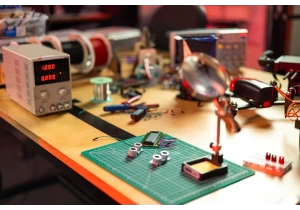As the trend toward miniaturization of electronic devices accelerates (e.g., 5G smartphones, TWS earbuds), SMD (surface-mount device) inductors have become a core component in compact PCB designs. This article combines industry trends and selection challenges to explain how to choose the right inductor based on size, efficiency, noise, and other requirements, while providing actionable selection strategies.
Industry Trends Driving Changes in SMD Inductor Demand
1. Device Miniaturization
Smartphone motherboards are now 30% smaller than five years ago, but functionality has increased by 200%. For example, the power module in the iPhone 14 uses a 2.0x1.6mm inductor, 15% smaller than its predecessor.
2. High-Frequency Requirements
5G base stations and WiFi 6E devices operate at frequencies up to 6GHz, requiring inductors to maintain low losses at higher frequencies. Traditional ferrite inductors experience significant losses above 3GHz, making low-temperature co-fired ceramic (LTCC) inductors the preferred choice.
3. High Power Density
The power density of electric vehicle onboard chargers (OBCs) has increased from 2kW/L to 4kW/L, necessitating metal composite core inductors capable of handling currents above 20A.
5 Key Parameters to Focus on During Selection
1. Size and Footprint
-
Key Data: Package specifications (e.g., 2520 represents 2.5x2.0mm) directly impact layout.
-
Case Comparison: Using a 3225 inductor (3.2x2.5mm) in a smartwatch charging module occupies 60% more space than a 2016 model, crowding out sensor areas.
Plain Explanation: Inductor size is like a parking space—smaller saves space, but you must ensure the "vehicle" (current load) can fit.
2. DC Resistance (DCR)
-
Formula: Power loss = I² × DCR. Reducing DCR by 50% cuts heat generation in half.
-
Test Data: A TWS earbud charging case using a 0.1Ω DCR inductor reduced temperature rise from 12°C to 5°C.
3. Saturation Current (Isat)
-
Definition: The current threshold at which inductance drops by 20%.
-
Risk Case: If a drone's ESC module inductor has insufficient Isat, sudden throttle increases can saturate the inductor, burning out the MOSFET.
4. Self-Resonant Frequency (SRF)
-
Selection Rule: Operating frequency should be below 70% of SRF.
-
Typical Issue: A router using an 800MHz SRF inductor for 1.2GHz signals experienced 30% efficiency loss.
5. Shielding Type
-
Open Core: Low cost but high electromagnetic interference (EMI), suitable for low-sensitivity devices like remote controls.
-
Fully Shielded: Metal casing reduces EMI by 20dB, essential for medical devices like ECG modules.
3-Step Selection Method: Matching Needs with Product Features
Step 1: Define the Application Scenario
-
High-Density Scenarios (e.g., smartwatches): Prioritize ultra-small 0201 (0.6x0.3mm) packages, sacrificing some current capacity for space savings.
-
High-Temperature Scenarios (e.g., car engine bays): Choose Sendust cores rated for 150°C instead of standard 125°C ferrite.
-
High-Frequency Scenarios (e.g., mmWave radar): LTCC inductors offer 40% lower loss @60GHz than traditional models.
Step 2: Calculate Key Parameters
-
Current Requirement: I_peak = 1.2 × I_avg (20% margin).
-
Space Constraints: Inductor height should be less than 80% of adjacent components (to avoid interfering with heat sinks).
Example:
A 4G module upgraded to 5G experienced signal distortion due to insufficient SRF in its 3A inductor. Replacing it with a wire-wound inductor (SRF=5GHz) reduced the error rate by 90%.
Step 3: Verify Supplier Data
-
Test Comparison: A supplier-specified 0.15Ω DCR inductor measured 0.18Ω under 3A load, causing an unexpected 2W heat loss.
-
Batch Consistency: Require suppliers to provide CPK≥1.33 process capability proof to ensure production stability.
Four Technological Advancements Enhancing Selection Flexibility
1. 3D-Printed Windings
Traditional winding processes limit wire diameter to ≥0.1mm, while laser printing achieves 0.05mm, reducing DCR by 30%.
2. Core Material Upgrades
-
Nanocrystalline Alloys: 50% lower high-frequency loss than ferrite, used in Huawei 5G base station AAU modules.
-
Silicone Potting: Improves vibration resistance from 10G to 30G, meeting industrial robot requirements.
3. Integrated Solutions
TDK's CLT32 series integrates inductors and capacitors, reducing footprint by 45%, used in Google Pixel fast-charging modules.
4. Smart Selection Tools
Murata's online simulator recommends models after inputting voltage/frequency, cutting selection time from 3 days to 10 minutes.
Common Mistakes and How to Avoid Them
Mistake 1: Blindly Pursuing Small Size
A pulse oximeter using a 008004 package (0.25x0.125mm) inductor achieved only 70% soldering yield, offsetting space savings with rework costs.
Solution:
-
0402 (1.0x0.5mm) is the cost-performance sweet spot, with >99% yield.
-
Ultra-small packages require nitrogen reflow soldering equipment.
Mistake 2: Ignoring Temperature Derating
A robot vacuum selected inductors for 25°C environments, but motor heat raised inductor temperatures to 85°C, reducing lifespan by 80%.
Fix:
-
Refer to IEC 62368 standards for actual operating temperatures.
-
Add thermal pads around inductors.
Mistake 3: Underestimating EMI Impact
An e-bike controller using non-shielded inductors caused 15% Bluetooth lock signal interference.
Improvement:
-
Fully shielded inductors cost 1.5 on EMI filters.
-
Add copper shielding on the PCB bottom layer.
Future Trends and Selection Recommendations
1. High-Frequency and Integration
GaN fast-charging solutions are driving adoption of 10MHz+ switching frequencies, requiring low-loss metal alloy inductors.
2. Smart Monitoring as Standard
Some inductors embed temperature sensors (e.g., Vishay IHLP series) for real-time health monitoring.
3. Stricter Green Manufacturing
EU ErP directives require inductors to have <500ppm lead content by 2025, favoring SnAgCu solder products.
Conclusion
Selecting inductors for compact PCB designs requires balancing size, efficiency, and cost. Key steps include:
-
Locking in core parameters based on application scenarios;
-
Leveraging new materials/processes to overcome traditional limitations;
-
Using simulation tools to validate design feasibility.
Engineers should create a selection checklist (size/DCR/SRF/Isat/shielding) and collaborate with suppliers for thermal simulation testing. This not only avoids redesigns but also enhances product competitiveness—optimizing inductor selection in TWS earbuds can extend battery life by 15%, making it a key selling point.
When selecting inductors, always ask: Will this model fail due to temperature, vibration, or aging during the device's lifecycle? Preventive design is 90% cheaper than post-failure fixes.

